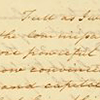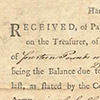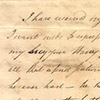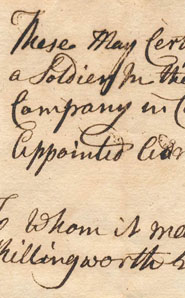|
- Verena Calas, National Park Service Museum Educator, Washington D.C
- 6-8 grades
- 5
[Back to top]
|
- This lesson unit plan draws on Valley Forge National Historical Park museum collections featured in the virtual museum exhibit at www.nps.gov/museum.
- Students will explore the challenges experienced by the Continental Army and its leadership, including General Washington, during their encampment at Valley Forge during the winter of 1777-1778 through object-based learning, hands-on activities, and active research. Students will work with and analyze primary source materials; including original Washington correspondence and other related documentation. Students will have the opportunity to make connections between the Revolutionary War period and the present by examining the similarities and differences between the original training manual of General Von Steuben and modern military manuals. Students will also practice analytical research, close reading, and debate skills through the examination of symbolism in colonial currency, the analysis of 18th century portraiture, and the discussion of women's role in the military.
- : During the American Revolution, General Washington and the fledgling Continental Army encountered many obstacles. However, from the Valley Forge encampment they emerge an organized and trained fighting force. Therefore, what obstacles did soldiers encounter while at Valley Forge? And, what factors contributed its emergence as a trained professional fighting force?
The following lesson plans are organized individually but make up a cohesive unit plan for "The Winter at Valley Forge". Teachers can choose to teach all five lessons as a unit, or each individually.
- This lesson introduces students to the challenges experienced by every day soldiers and their commanding officers during the winter at Valley Forge and explores how they dealt with these challenges not only physically, but mentally, as well.
- This lesson introduces students to the primary source documentation and analysis through the correspondence of men living in the Valley Forge encampment. Students will get another look into the challenges the camp presents as well as the emotional toll war can on the soldiers fighting it.
- This lesson explores the military training and tactics introduced by General Von Steuben at Valley Forge. Students will explore the importance of military manuals as modes of sharing information amongst large organized groups.
- This lesson explores the various rolls of women at the Valley Forge encampment. Students will compare the experiences of Valley Forge women to the changing rolls of American women in the military throughout history and partake in a class debate.
- This lesson explores the different kinds of currency and symbolism used not only in the Valley Forge Camp, but in the Thirteen Colonies at large. Students will also engage in the mathematical exchange of money.
[Back to top]
|
| This lesson introduces students to the challenges experienced by every day soldiers and their commanding officers during the winter at Valley Forge and explores how they dealt with these challenges not only physically, but mentally, as well. |
| MUSEUM OBJECT [photos of objects in the Parks museum collections] |
SIMILAR OBJECTS [local items similar to museum objects] & OTHER MATERIALS |
Length of time |
|
 |
 |
Washington's Letter to Henry Laurens |
Carter Pay Order |
 |
|
Washington's Letter to Henry Laurens |
|
|
|
55
minutes |
|
- Examples of Postcards
- Postcard sized cardstock pieces
- Pens and pencils
- Markers of assorted colors
- Crayons/colored pencils of assorted colors
- White glue
- Construction paper of assorted colors
|
55
minutes |
[Back to top]
|
Determine the meaning of words and phrases as they are used in a text, including vocabulary specific to domains related to history/social studies.
Cite specific textual evidence to support analysis of primary and secondary sources.
Determine the central ideas or information of a primary or secondary source; provide an accurate summary of the source distinct from prior knowledge or opinions.
Identify aspects of a text that reveal an author's point of view or purpose (e.g., loaded language, inclusion or avoidance of particular facts).
[Back to top] |
- SWBAT use the analysis of primary source documents to identify obstacles faced by soldiers and their commanding officers during their time at camp.
- SWBAT create original pieces of creative writing that analyze and describe daily life at the Valley Forge camp.
- SWBAT analyze and read primary source documents.
- SWBAT annotate primary sources.
[Back to top]
|
The Winter at Valley Forge: Background Information (PowerPoint)
[Back to top]
|
Annotate: to make critical notes or comments.
[Back to top]
|
|
- Separate students into groups according to reading level and assign appropriate reading to each group.
- Do model annotation with one primary source documents as a whole class.
[Back to top] |
- Completed annotations and strengths/weaknesses evaluation for the primary source documents.
- Completed letter about the conditions of Valley Forge.
[Back to top]
|
|
|
|
|




